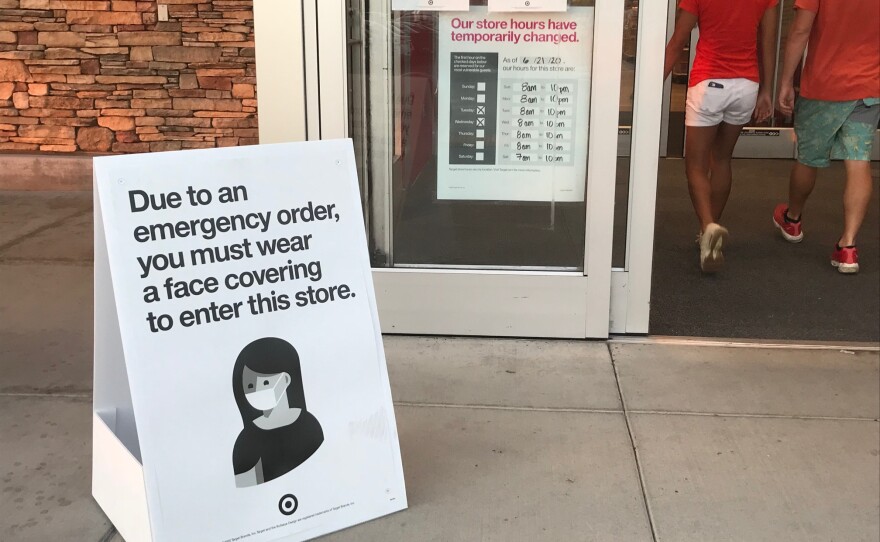San Diego County public health officials have reported 330 new COVID-19 cases and four additional coronavirus fatalities, raising the region's total to 55,540 cases and 881 deaths.
Wednesday's statistics came a day after the county avoided the state's "purple" tier for yet another week, remaining in the less restrictive "red" tier of the state's four-tiered coronavirus monitoring system.
The county's adjusted case rate dropped to 6.5 new daily COVID-19 cases per 100,000 population, which is far from ideal, but allows the county to maintain some semblance of normalcy.
RELATED: US Coronavirus Cases Surpass Summer Peak And Are Climbing Higher Fast
"We're holding steady in San Diego County," said County Supervisor Nathan Fletcher at a weekly meeting of county officials Wednesday.
He pointed to examples of places not holding steady throughout the country and globe, with exponential growth in case numbers causing significant backsliding and heavily taxing local health infrastructure.
"We have to redouble our efforts," he said, referring to the approaching winter and flu season. "This has the potential to take off."
Steve Padilla, a Chula Vista councilman and the first elected official in California to publicly be infected with COVID-19, spoke at the county meeting Wednesday about his medically induced coma and how the fever burned nearly 7,000 calories a day. Padilla lost nearly 30 pounds in his 12 days in intensive care.
"It's quite a workout, but not the one I would recommend," he said.
Padilla encouraged San Diegans to take the illness seriously, noting even healthy people can be hospitalized, intubated or may succumb to the virus even though it has a mortality rate of less than 2% locally.
Of the tests reported Wednesday, 3% returned positive, bringing the 14- day rolling average percentage of positive cases to 2.7%. The 7-day daily average of tests is 11,278.
A total of 13 new community outbreaks were confirmed Wednesday, bringing the total in the past week to 31 outbreaks representing 133 cases. Of the new community outbreaks, four were reported in grocery stores, three in restaurants, two in healthcare settings, two in unspecified government settings, one in a daycare and one in a business.
A community outbreak is defined as three or more COVID-19 cases in a setting and in people of different households over the past 14 days.
Of all cases, 3,883 — or 7% — have required hospitalization. And 905 — or 1.6% — of all cases and 23.2% of hospitalized cases had to be admitted to an intensive care unit.
Dr. Wilma Wooten, the county's public health officer, said the three most common co-morbidities with COVID-19 in the region were hypertension, diabetes and heart disease.
According to the California Department of Public Health, the county's unadjusted case rate is 7.4 per 100,000 — enough to be in the most restrictive purple tier, which has a floor of 7 per 100,000. However the high volume of tests the county is able to perform daily allows for an adjustment from the state. This adjustment has kept the county in the red tier for several weeks, saving it from having to shut down nearly all nonessential indoor businesses.
The state data, which is updated every Tuesday, reflects the previous week's case data to determine where counties stand in the state's four-tiered reopening system.
San Diego County did show modest improvement, dropping 0.4 from last week's unadjusted case rate of 7.8. The testing positivity rate continued an upward trend, rising 0.2% from last week to reach 3.5%, but remains low enough for this metric to remain in the orange tier. If a county reports statistics meeting metrics in a higher tier for two consecutive weeks, it will move into that more restrictive tier for a minimum of three weeks.
The state's health equity metric, which looks at the testing positivity for areas with the lowest healthy conditions, dropped from 5.5% to 5.1% and entered the orange tier. This metric does not move counties backward to more restrictive tiers, but is required to advance.
All students at San Diego State University remain under a stay-at-home advisory. The advisory began at 6 p.m. Friday and will run through Monday at 6 a.m. University officials said the move was made to discourage students from participating in Halloween events in which physical distancing cannot be done. Students are advised to stay home unless they have an essential need.
Less than a week after fully reopening its schools, the Vista Unified School District reported four additional COVID-19 cases Monday, including two Mission Vista High School students, one Roosevelt Middle School student and one Alamosa Park Elementary School student.
On Tuesday, the district confirmed two additional cases — one at Mission Meadows Elementary School and one at Alamosa Park Elementary School.
According to the district's COVID-19 safety dashboard, it has recorded 10 cases since Sept. 8, with six of those coming after Oct. 20.
The VUSD Board voted Tuesday to shut down at least one campus for two weeks starting Thursday as a result of the rising cases. At least 400 students and nearly two dozen staff members have been ordered to quarantine.
Mission Vista High School will move to distance learning for at least two weeks starting today, while Alta Vista High School and Roosevelt Middle School also face potential closures.








